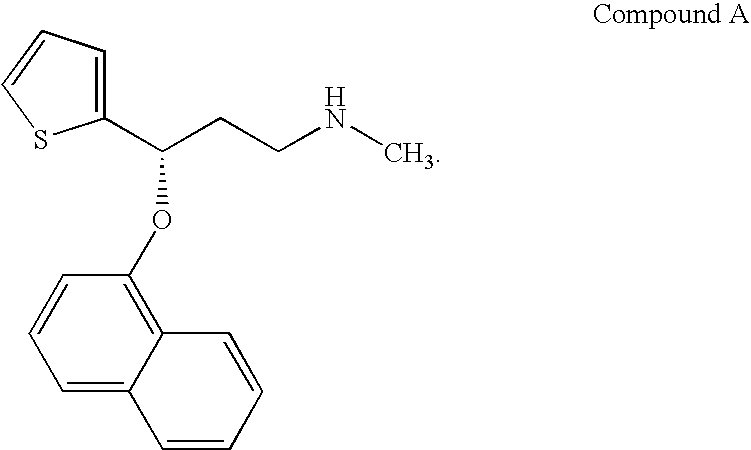Novel aryloxypropanamines
a technology of aryloxypropanamine and aryloxypropanamine, which is applied in the field of aryloxypropanamine, to achieve the effects of reducing the metabolism rate, substantial isotope effect, and speeding up reaction ra
- Summary
- Abstract
- Description
- Claims
- Application Information
AI Technical Summary
Benefits of technology
Problems solved by technology
Method used
Image
Examples
example 1
[0239] 1-Fluoro-2,3,4,5,6,7,8-heptadeuteronaphthalene. Two synthetic methods are described.
[0240] Method A: Cool a solution of 1-naphthol-d7 (available from Isotec, Miamisburg Ohio, or by the method of Guthrie R D and Shi B, J. Am. Chem. Soc. 1990 112: 3136) (4.0 mmol) in 60 mL of toluene, cooled in an ice / water bath, and treat dropwise over about 1 min with 4.2 mmol of phosgene, followed by dropwise addition during about 1 min 4.2 mmol of N,N-dimethylaniline. After about 10 min, add about 0.5 mL of water dropwise carefully during about 1 min. Dilute the mixture with about 10 mL of toluene and wash sequentially with water, 0.1 N HCl, 0.1 N NaOH, and saturated brine, then dry over anhydrous magnesium sulfate and evaporated to yield an oily residue. Kugelrohr distill to yield naphthyl-1-chloroformate-d7.
[0241] Add anhydrous potassium fluoride (5 mol) to a stirred solution of naphthyl-1-chloroformate-d7 (3.5 mol) and 18-crown-6 (0.17 mol) in 3 mL of dichloromethane (250 mL) at room t...
example 2
[0244] (S)-N,N-dimethyl-3-(2,3,4,5,6,7,8-heptadeuteronaphthalen-1-yloxy)-3-(thiophene-2-yl)propan-1-amine. Treat a solution of 3.1 mmol (S)-(−)-N,N-dimethyl-3-hydroxy-3-(2-thienyl)propanamine (Berglund, R A, U.S. Pat. No. 5,362,886 to Eli Lilly) in 3 ml of dimethylsulfoxide, under argon at ambient temperature, with 0.12 g of sodium hydride as a 60% dispersion in mineral oil and stir the mixture vigorously. After 30 minutes of stirring, add 90 mg of potassium benzoate and continue stirring for 10 minutes more. Add 3.1 mmol of 1-fluoronaphthalene-d7 and stir the mixture at 50° C. for 8 hours. Pour the reaction mixture into 30 ml of cold water and adjust the pH to 4.8 by addition of acetic acid. Add 5 mL of hexane, then stir for 10 minutes, and are separate the layers. Stir the aqueous phase again with 15 ml of hexane and separate the phases. Adjust the pH of the aqueous phase to about 12.5 by addition of aqueous sodium hydroxide, and add 15 ml of ethyl acetate. Stir the basic mixture ...
example 3
[0245] (S)-N-methyl-3-(2,3,4,5,6,7,8-heptadeuteronaphthalen-1-yloxy)-3-(thiophene-2-yl)propan-1-amine hydrochloride (Compound 8). Heat a solution of 6 mmol of the product of Example 2 in 12 of toluene to 55° C. Then add 7.2 mmol of diisopropylethylamine, followed dropwise by 9 mmol of phenyl chloroformate. Stir the mixture at 55° C. for 1.25 hours, then add 15 ml of 1% sodium bicarbonate solution. Stir the mixture for ten minutes at about 45° C., and separate the phases. Wash the organic phase twice with 0.5N hydrochloric acid, then with 1% sodium bicarbonate solution. Evaporate the washed organic phase under vacuum take up the residue in 30 ml of dimethylsulfoxide. Heat the mixture to 45° C. and add 30 mmol of sodium hydroxide and 36 ml of water dropwise. Stir the basic mixture for about 16 hours at 50° C., dilute with 20 ml of water, and acidify to pH 5.0-5.5 by addition of acetic acid. Add 24 ml of hexane, stir the mixture for ten minutes, and separate the phases. Basify the aque...
PUM
| Property | Measurement | Unit |
|---|---|---|
| Fraction | aaaaa | aaaaa |
| Current | aaaaa | aaaaa |
| Concentration | aaaaa | aaaaa |
Abstract
Description
Claims
Application Information
 Login to View More
Login to View More - R&D
- Intellectual Property
- Life Sciences
- Materials
- Tech Scout
- Unparalleled Data Quality
- Higher Quality Content
- 60% Fewer Hallucinations
Browse by: Latest US Patents, China's latest patents, Technical Efficacy Thesaurus, Application Domain, Technology Topic, Popular Technical Reports.
© 2025 PatSnap. All rights reserved.Legal|Privacy policy|Modern Slavery Act Transparency Statement|Sitemap|About US| Contact US: help@patsnap.com



